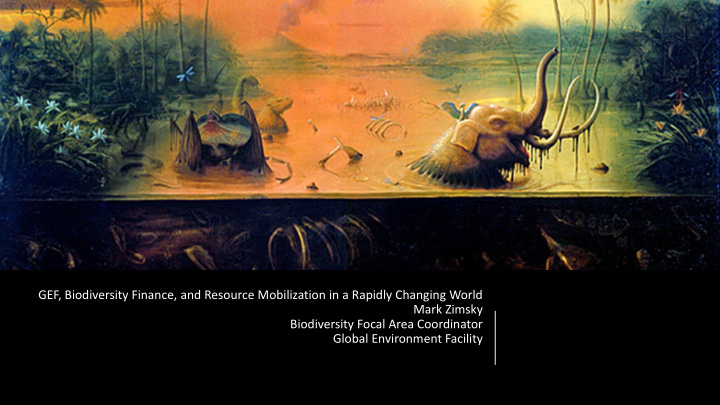



GEF, Biodiversity Finance, and Resource Mobilization in a Rapidly Changing World Mark Zimsky Biodiversity Focal Area Coordinator Global Environment Facility
What is the Global Environment Facility (GEF): The GEF is the world’s leading public financial fund investing in the joint management, care, and restoration of our planet. 1- Financial Mechanism 2- Global Partnership 3- Important track of the Multilateral record of investments Environmental 183 countries Agreements • GEF created in 1991 • Over $18 billion in grants 18 Implementing Agencies + $94 billion in co- financing • $4.8 billion biodiversity • More than 4500 projects in 163 countries . + Private sector, Academic institutions…
Socioeconomic megatrends: by 2030 8.5bn people, 60 per cent in cities, 5bn middle class consumers
60-70% more food 60 needed by 2050 Food and agriculture 37% of f lan land use se 24% GHG emiss issio ions 11% undernouris ished
Finance Needs The High-Level Panel on the Global Assessment of Resources for Implementing the Strategic Plan for Biodiversity 2011-2020, based on the 20 Aichi Biodiversity Targets, estimated the global financing needs for achieving the CBD Strategic Plan at between US$ 150-440 billion per year by 2020.
Whither GEF-7 (2018-2022) Programming Strategy?
GEF-7 response: …collective efforts to transform key so tr social l an and • Impact Programs: • multiple, global economic systems that • Food Systems, Land- environmental put the planet at risk, use, Restoration benefits: (FOLUR) • biodiversity • Sustainable Cities • food • land • Sustainable Forest • urban • climate change Management (SFM) • energy • chemicals & waste Car arefully targeted, catalyt ytic in investments contribute thereby maximizing towards… the GEF’s positive im impact
GEF-7 Programming Framework Focused and Complementary Approach Convention Guidance - Focal Area Strategies BD, CC, LD, IW, CW Focused Focal Area Impact Programs Investments Global Environmental Benefits for Biodiversity, Climate Change, Land Degradation, International Waters, and Chemicals and Waste
Resource mobilization: creative and innovative ways to increase resource flows as the financial mechanism of the CBD Leveraging GEF Support • Impact Programs: Improve the value of each dollar spent through more strategic and integrated investments that address drivers of BD loss • Impact Programs = financial incentives-> 2:1, leverages more $ for biodiversity — FOLUR and SFM • BD Focal area strategy = BD mainstreaming including natural capital assessment and accounting
Resource Mobilization: Working with the private sector • The pace of environmental degradation is accelerating and requires new approaches • The private sector is responsible for 80% of all economic activity and is increasingly dependent on scarce natural resources • The private sector has the capacity to rapidly innovative and deploy sustainable solutions • Public-private partnerships can address non- market barriers and reduce risk to foster sustainability
Leveraging private sector • Impact Program implementation supported by multi- stakeholder platforms and partnerships of public and private sector at national and international levels, including financial intermediaries. • Value chains as an entry point for leveraging transformation
Leveraging private sector • Non-grant instrument expanded in GEF-7: through debt, equity, or risk guarantees designed to pursue innovative blended finance to catalyze private sector investment in natural resources management.
GEF’s Non Grant Instruments for Blended Finance Financial Resources Asset Financial Performance +$ Fully Creditworthy Commercial Finance Becoming Creditworthy NGI Program Breakeven includes: - Debt Blended Finance GAP - Guarantees - Equity Unproven Track record Grants/Subsidies Loss Making -$
GEF-7 Blended Finance Focus In GEF-7 , the NGI Program expands the use of non-grant instruments to catalyze investments from private sector and capital markets. The focus is on: 1. Scalability: financial structures or investment platforms aimed at scaling-up for greater impact including appropriate levels of co-financing; 2.Sound financial terms; 3.Innovation.
Thank you. Mark Zimsky (mzimsky@thegef.org) Biodiversity Coordinator Global Environment Facility Trondhiem Biodiversity Conference, June 2019
Coalition for Private Investment in Conservation: NGI Case Innovative partnership launched at 2016 IUCN World Conservation Congress and with more than 100 coalition partners : public and private financial agencies, philanthropic, conservation organisms to deliver a set of innovative private sector deals.
CPIC: Finance Structure GEF Non Grant Instruments 8 250 000; 13 % 2 838 000; 5 % Grants: Rockefeller Foundation, TNC, Cornell Atkinson Center, IBAT, IUCN, Newcastle University 50 000 000; 82 % Private Sector co-financing
Recommend
More recommend